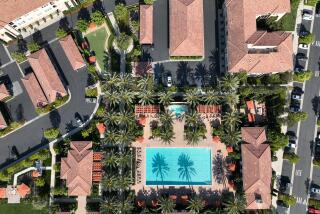It Was a Dirty Job, but Many Wanted to Do It
Peeling off plastic gloves encased in heavy mud, Susan Coats was more focused on her heart than her hands.
“I prayed over this,”’ she said. “I was passing by last week and when I saw the mission in such bad shape, it broke my heart, both as a Californian and as a Christian. Then when I saw the flier asking for help -- well, here I am.”
A school psychologist from Los Angeles, Coats had been scooping mud, glorious mud into wood frames from a wheelbarrow pushed by a Franciscan novice wearing a long brown robe, black socks, and an oddly jaunty straw hat. She had driven more than 200 miles to this tiny town north of Paso Robles to help in the planned rebuilding of Mission San Miguel, a long, laborious process that suffered a near-terminal setback with an earthquake in 2003.
Coats was one of several dozen volunteers who heeded a call for unskilled labor put out by a group called the Friends of Mission San Miguel. The task at hand was the fabrication of some 5,000 adobe bricks, weighty blocks that will replace others that date from the mission’s construction two centuries ago. More than 200 people have signed on for the task at various days over the next week.
State and federal funds for the restoration of California’s deteriorating missions have been held up by legal challenges, and the church at San Miguel remains a closed-off hulk, severely cracked from earthquakes and tottering from time. Other areas are also closed in the sprawling mission, which is in such desperate need of repair that the National Trust for Historic Preservation in May named San Miguel one of the 11 most endangered historic sites in the U.S.
The Diocese of Monterey has said it can’t afford to pay for the reconstruction, so various jobs have been underwritten by private donations, enchilada sales, bingo games -- and, on Saturday, the free labor of cheery volunteers.
Starting at 7 a.m., they formed a low-tech assembly line, using the kind of procedures that have gone into making adobe bricks for thousands of years. Men with shovels dug into a mound 8 feet high, soaked the dirt with water and dumped it into a gas-powered mixer, the day’s one nod to modernity.
Then a line of people with mud-heavy wheelbarrows pushed their way to another group that unloaded the mud into wooden rectangles. After a few hours, the volunteers were tired out and more than 400 4-inch-thick bricks lay baking in three neat rows in the sun like so many devil’s-food sheet cakes. The rows were neatly wrapped in paper that must be moistened every few hours for days to keep the bricks from drying too quickly.
Although the basics are Stone Age-simple -- get dirt, add water -- the details require the expertise of someone like Tim Aguilar, a brick maker in the Santa Ynez Valley for decades and the guiding force behind the restoration of thousands of bricks at the Presidio in Santa Barbara.
Use dirt without enough clay and the bricks will crumble, Aguilar said. Use too much water and they’ll dissolve. If you dry them in too much heat, the outsides will brown but the insides will remain as moist as a medium-rare Chateaubriand. The result: cracked, weakened, unusable bricks.
Aguilar deemed the dirt that had been scraped by a bulldozer off a long-dormant mission farm field “fantastic stuff” -- cohesive enough to build a decent brick without adding straw or other materials.
As the morning warmed up, Shirley Macagni took a break to survey the scene. When the mission was operating at its capacity in the early 1800s, her ancestors were among the 1,200 Salinan Indians who lived within its walls. Some, she said, may even have made the bricks that these were intended to replace in boarded-up living quarters and other spots around the complex.
“We look on the missions as a treasure,” said Macagni, a 73-year-old tribal elder who has used San Miguel’s detailed records of births, baptisms, weddings and deaths to trace her lineage. “Of course the padres were making our people work and converting them, but I don’t look on that as such a bad thing.”
Thousands of Indians died -- mostly from disease -- in California’s missions, and the extent to which they were abused has been a matter of sometimes bitter debate both inside and outside the scholarly community for years. Some academics have leveled charges of genocide against Padre Junipero Serra and the other founders of the mission system, but other experts contend that the Indians fared better than generally thought.
But on Saturday, the realities of mud and sun seemed more urgent than the perennial dispute.
At 28, Jimmy Nagel had never made a brick and wasn’t particularly looking forward to it. A Franciscan novice, he has lived at the mission with three other novices and about 10 monks since June. His last posting was in the slums of New York City, where he worked at a shelter helping street-tough kids put together resumes and learn job-interviewing skills.
“Making bricks was just something else on my to-do list,” he said as he paused with a wheelbarrow full of muck. “But now that I’ve gotten my hands dirty, I guess you could say I’ve been touched by history.”
More to Read
Start your day right
Sign up for Essential California for news, features and recommendations from the L.A. Times and beyond in your inbox six days a week.
You may occasionally receive promotional content from the Los Angeles Times.







